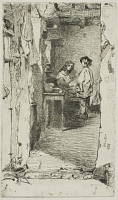Rag Pickers, Quartier Mouffetard, Paris | ||
| Number: | 29 | |
| Date: | 1858 | |
| Medium: | etching and drypoint | |
| Size: | 152 x 90 mm | |
| Signed: | 'Whistler' at lower right | |
| Inscribed: | '1858' at lower right (5) | |
| Set/Publication: | no | |
| No. of States: | 5 | |
| Known impressions: | 80 | |
| Catalogues: | K.23; M.23; T.31; W.17 | |
| Impressions taken from this plate (80) | ||
TECHNIQUE
This plate was conceived and executed primarily in etching. The only certain drypoint lines are those of the date '1858', which was added in the final state.
PRINTING
An exceptional number - over eighty - impressions of Rag Pickers, Quartier Mouffetard, Paris are known. The copper plate has not been located, and some of these impressions were either printed in the 1890s or after Whistler's death.
Early impressions are printed in black ink on ivory (darkened to buff) laid paper with a shell watermark ( ); off-white wove (
); off-white wove ( ); and ivory wove paper taken from a book (
); and ivory wove paper taken from a book ( ). There are impressions of the fourth state on various papers including cream laid paper, possibly Asian (
). There are impressions of the fourth state on various papers including cream laid paper, possibly Asian ( ); ivory 'antique' (pre-1800) laid paper with 'FORGE' watermark (
); ivory 'antique' (pre-1800) laid paper with 'FORGE' watermark ( ); cream laid with 'F' and 'E' countermarks (
); cream laid with 'F' and 'E' countermarks ( ); and thick card-like wove (
); and thick card-like wove ( ).
).
 ); off-white wove (
); off-white wove ( ); and ivory wove paper taken from a book (
); and ivory wove paper taken from a book ( ). There are impressions of the fourth state on various papers including cream laid paper, possibly Asian (
). There are impressions of the fourth state on various papers including cream laid paper, possibly Asian ( ); ivory 'antique' (pre-1800) laid paper with 'FORGE' watermark (
); ivory 'antique' (pre-1800) laid paper with 'FORGE' watermark ( ); cream laid with 'F' and 'E' countermarks (
); cream laid with 'F' and 'E' countermarks ( ); and thick card-like wove (
); and thick card-like wove ( ).
). There are at least fifty impressions of the final (fifth) state with the figures, which were presumably printed in or after 1861, and some much later. They include impressions in black ink on Japanese paper ( ,
,
 ,
,
 ); on wove (
); on wove ( ,
,
 ); and on laid
paper (
); and on laid
paper ( ,
,  ) including greenish/grey paper from a book (
) including greenish/grey paper from a book ( ); and laid paper with water- or counter-marks, such as 'IV' (
); and laid paper with water- or counter-marks, such as 'IV' ( ), a crown (
), a crown ( ,
,  ), '1820' (
), '1820' ( ), and possibly Strasbourg Bend with 'W' (
), and possibly Strasbourg Bend with 'W' ( ). Nearly all impressions are in black ink, but a few are in dark brown ink (
). Nearly all impressions are in black ink, but a few are in dark brown ink ( ,
,
 ,
,
 ).
).
 ,
,
 ,
,
 ); on wove (
); on wove ( ,
,
 ); and on laid
paper (
); and on laid
paper ( ,
,  ) including greenish/grey paper from a book (
) including greenish/grey paper from a book ( ); and laid paper with water- or counter-marks, such as 'IV' (
); and laid paper with water- or counter-marks, such as 'IV' ( ), a crown (
), a crown ( ,
,  ), '1820' (
), '1820' ( ), and possibly Strasbourg Bend with 'W' (
), and possibly Strasbourg Bend with 'W' ( ). Nearly all impressions are in black ink, but a few are in dark brown ink (
). Nearly all impressions are in black ink, but a few are in dark brown ink ( ,
,
 ,
,
 ).
). It is very likely that some of these impressions of the final state were printed in the 1890s or after Whistler's death. Another example of a possible late printing is in black ink on blue-tinged off-white 'modern' paper ( ) and was bequeathed by Frederick Keppel (1845-1912), who may well have been involved in organising a late print-run, to the Museum of Fine Arts, Boston.
) and was bequeathed by Frederick Keppel (1845-1912), who may well have been involved in organising a late print-run, to the Museum of Fine Arts, Boston.
 ) and was bequeathed by Frederick Keppel (1845-1912), who may well have been involved in organising a late print-run, to the Museum of Fine Arts, Boston.
) and was bequeathed by Frederick Keppel (1845-1912), who may well have been involved in organising a late print-run, to the Museum of Fine Arts, Boston.
